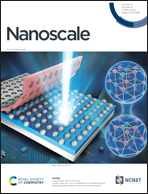Employing bicontinuous-to-micellar transitions in nanostructure morphology for on-demand photo-oxidation responsive cytosolic delivery and off–on cytotoxicity†
Abstract
Bicontinuous nanospheres (BCNs) are underutilized self-assembled nanostructures capable of simultaneous delivery of both hydrophilic and hydrophobic payloads. Here, we demonstrate that BCNs assembled from poly(ethylene glycol)-block-poly(propylene sulfide) (PEG-b-PPS), an oxidation-sensitive copolymer, are stably retained within cell lysosomes following endocytosis, resisting degradation and payload release for days until externally triggered. The oxygen scavenging properties and enhanced stability of the bicontinuous PEG-b-PPS nanoarchitecture significantly protected cells from typically cytotoxic application of pro-apoptotic photo-oxidizer pheophorbide A and chemotherapeutic camptothecin. The photo-oxidation triggered transition from a bicontinuous to micellar morphology overcame this stability, allowing on-demand cytosolic delivery of camptothecin for enhanced control over off–on cytotoxicity. These results indicate that inducible transitions in the nanostructure morphology can influence intracellular stability and toxicity of self-assembled nanotherapeutics.



 Please wait while we load your content...
Please wait while we load your content...
